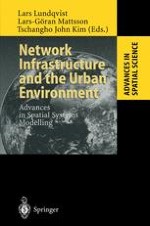1998 | OriginalPaper | Buchkapitel
Applied Models of Urban Land Use, Transport and Environment: State of the Art and Future Developments
verfasst von : Michael Wegener
Erschienen in: Network Infrastructure and the Urban Environment
Verlag: Springer Berlin Heidelberg
Enthalten in: Professional Book Archive
Aktivieren Sie unsere intelligente Suche, um passende Fachinhalte oder Patente zu finden.
Wählen Sie Textabschnitte aus um mit Künstlicher Intelligenz passenden Patente zu finden. powered by
Markieren Sie Textabschnitte, um KI-gestützt weitere passende Inhalte zu finden. powered by
The idea that computer models of urban land use and transport might contribute to more rational urban planning was bom in the 1950s and culminated in the 1960s. The ‘new tools for planning’ (Harris, 1965) were thought to be a major technological breakthrough that would revolutionise the practice of urban policy making. However, the diffusion of urban models faltered soon after the pioneering phase, for a variety of reasons (see Batty, 1994; Harris, 1994). The most fundamental reason was probably that these models were linked to the rational planning paradigm dominant in most Western countries at that time. They were perhaps the most ambitious expression of the desire to ‘understand’ as thoroughly as possible the intricate mechanisms of urban development, and by virtue of this understanding to forecast and control the future of cities (Lee, 1973). Since then the attitude towards planning has departed from the ideal of synoptic rationalism and turned to a more modest, incrementalist interpretation of planning that has at least partly determined the failure of many ambitious large-scale modelling projects.
